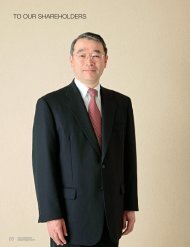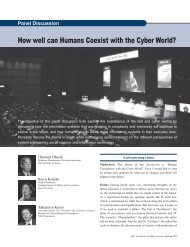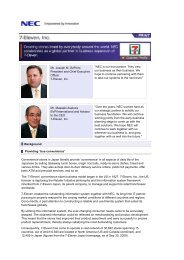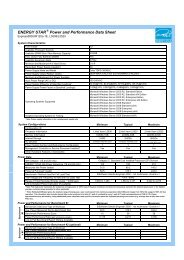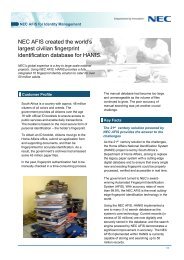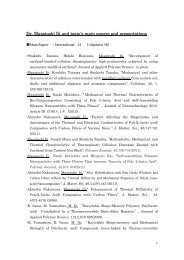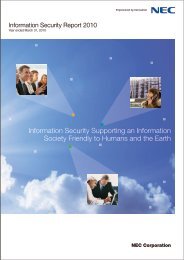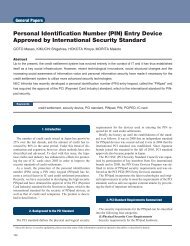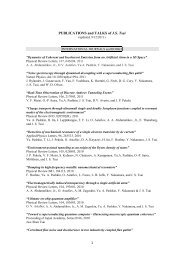Technologies Behind NEC's High Temperature Ambient Server
Technologies Behind NEC's High Temperature Ambient Server
Technologies Behind NEC's High Temperature Ambient Server
Create successful ePaper yourself
Turn your PDF publications into a flip-book with our unique Google optimized e-Paper software.
<strong>Technologies</strong> <strong>Behind</strong> NEC’s <strong>High</strong> <strong>Temperature</strong> <strong>Ambient</strong> <strong>Server</strong><br />
1. What Are <strong>High</strong> <strong>Temperature</strong> <strong>Ambient</strong> (HTA)<br />
<strong>Server</strong>s and Storage Devices?<br />
1.1 Introduction<br />
Cloud computing and other advanced information & communications technologies (ICT)<br />
are changing business and society. But as cloud services expand, so do the data centers<br />
housing the increasingly large numbers of servers and storages devices required to<br />
deliver these services, leading to increased power consumption. Corporations looking to<br />
make their data centers more power efficient and reduce their operating overhead are<br />
therefore searching for new and effective power saving measures.<br />
To address these issues, NEC is providing HTA servers and storage devices as well<br />
as solutions to help improve the power efficiency of the cooling systems and facility<br />
equipment used in data centers. This paper describes NEC’s technologies for<br />
realizing HTA servers and storage devices, including the verification tests<br />
performed on the HTA servers and storage devices.<br />
1.2 Steps taken by NEC to realize power<br />
saving servers and storage devices<br />
Looking at a data center’s power consumption figures classified by usage, ICT<br />
equipment such as servers and storage devices accounts for 53% of consumed<br />
power, whereas the cooling systems, power distribution, lighting equipment, and<br />
other facilities account for the rest (47%). (These are actual values measured in an<br />
NEC data center.) In fact, the cooling systems accounts for as much as 31% of data<br />
center power consumption. It is therefore important to reduce the power consumed<br />
by the cooling system as well as by ICT equipment in order to achieve power savings<br />
in data centers.<br />
Power Consumption in Data Center Classified by Usage<br />
Lighting and<br />
other equipment<br />
Power supply<br />
equipment<br />
7<br />
9<br />
1.3 NEC’s HTA servers and storage devices<br />
To achieve further power reduction, NEC has released a platform that operates in<br />
HTA servers and storage devices that operate up to 40 degrees Celsius (104<br />
degrees Fahrenheit).<br />
The maximum ambient operating temperature for conventional servers and<br />
storage devices is generally 35°C. NEC has successfully increased this limit by<br />
5°C to 40°C by selecting components that enable optimization of cooling design<br />
and airflow. This makes it possible to set the cooling system in the data center to a<br />
higher temperature, reducing the power consumption.<br />
The figure below shows an example of a customer that is using ICT equipment<br />
installed in 2007. If this customer replaces their existing devices with NEC’s HTA<br />
power saving servers and storage devices, the ICT equipment will consume less<br />
power and therefore generate less heat. This means that the cooling system will<br />
need less power to cool the data center. Power consumption can also be reduced<br />
by elevating the cooling system temperature setting by 5°C. These measures add<br />
up to a reduction in cooling system power consumption of approximately 40% and<br />
a decrease in data center power consumption of 34% (as estimated by NEC).<br />
Breakdown of current power<br />
consumption in data center* 1<br />
Other facilities: 16%<br />
Cooling: 31%<br />
Networks: 11%<br />
Storage devices: 9%<br />
<strong>Server</strong>s: 33%<br />
Before<br />
Reduced by<br />
40%<br />
Reduced by<br />
50%<br />
Reduced by<br />
53%<br />
*1 Actual values measured in an NEC data center<br />
Power consumption<br />
reduced by<br />
34%<br />
After<br />
Cooling system<br />
31<br />
ICT<br />
equipment<br />
53<br />
2. NEC’s <strong>Technologies</strong> for<br />
Realizing HTA Products<br />
Power saving measures for cooling systems are as important<br />
as improving the power efficiency of ICT equipment.<br />
NEC has been addressing power saving for IT platforms since 2007. We have achieved<br />
significant power savings in server and storage devices by implementing the internal<br />
airflow designs and cooling technologies proven by us in supercomputer and<br />
mainframe development.<br />
With the rapid shift to cloud computing, ICT systems are being consolidated in data<br />
centers, making it important to implement power saving measures for the whole data<br />
center, including the cooling system, power supply equipment, and lighting equipment.<br />
Determined to take a proactive approach to an issue that all corporations will have to<br />
address, NEC launched a project in 2010 to save power in data centers as a whole.<br />
NEC provides HTA servers in its Express5800 series x86 server lineup. The Express5800<br />
series incorporates the Intel® Xeon® processor with excellent power efficiency. Power<br />
consumption by these servers is also reduced by adopting the<br />
80 PLUS® PL ATINUM power supply with high conversion<br />
efficiency along with other power saving components.<br />
In addition, the Express5800 series lets you set a power cap<br />
value to control power by using the bundled ESMPRO server management software.<br />
In addition to the power saving features in the server itself, NEC has also thoroughly<br />
reviewed the airflow design and cooling components in the housing to enable high<br />
temperatures. The following sections describe NEC’s original designs for realizing power<br />
saving.<br />
© 2012 NEC Corporation The NEC logo is a registered trademark or a trademark of NEC Corporation in Japan and other countries.<br />
2





